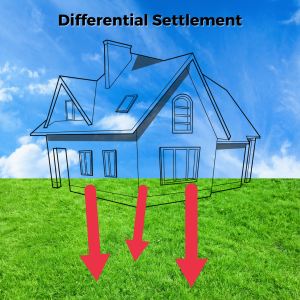There are different problems that can lead to a failing foundation, however today we are going to focus on settlement. There are 3 different ways that your home can settle, and with each the symptoms that you can expect to see are different types of foundation cracks.
Foundation cracks are often the first warning signs that settlement is occurring, and with regular monitoring of your foundation you can catch them quickly. This article will give you and idea of what to look out for. This is important because depending on the type of settlement you have, the solution may be different.


Uniform Settlement is exactly what it sounds like. This occurs when the soils shift downward uniformly under your home. This means that the entire foundation moves downward together, at the same rate, evenly.
In many cases, you will not see foundation cracks with this type of settlement, as the downward motion is uniform. Due to the fact that the soils around your home are always putting pressure on it, any movement can cause foundation cracks. In the case of uniform settlement however, they may be small, and of no immediate consequence. Continue to monitor them.


This type of settlement occurs when the soils beneath your home move downward unevenly. This is caused when your home is built on different layers of soil, poorly compacted soil, or soil that is stronger in some areas and weaker in others.
When this happens you may see sticking doors and windows, or cracks around them. In addition you may see stair-step cracks or wider more frequent cracks. Once this happens the situation is more urgent and could be a sign of a failing foundation. An inspection should be scheduled right away.


Tipping settlement is when the soil settles more on one side of your home than the other causing one side to settle at a faster rate than the other. This may cause the structure to tilt to one side.
You may expect to see cracks that are larger than a hairline crack, around the exterior of your home. Additionally, you may notice cracks around floors, doors, windows, and even drywall cracks. A failing foundation could occur if the problem remains unchecked. If you have concerns that your home may be tipping due to settlement, do not hesitate to contact Tar Heel Foundation Solutions for an inspection.
If you suspect your foundation is failing due to foundation settlement you should start with an inspection. Your structural contractor from Tar Heel may recommend helical underpinning. During this process helical piers are drilled deep into load bearing strata under your home to restore stability and prevent further settlement. Tar Heel Foundation Repair uses Helical Piers manufactured in the USA by Earth Contact Products (ECP) that are considered industry best.
Contact our team today to discuss your home’s foundation. We are here to help. For a free inspection, fill out our contact form and we will get right back to you!